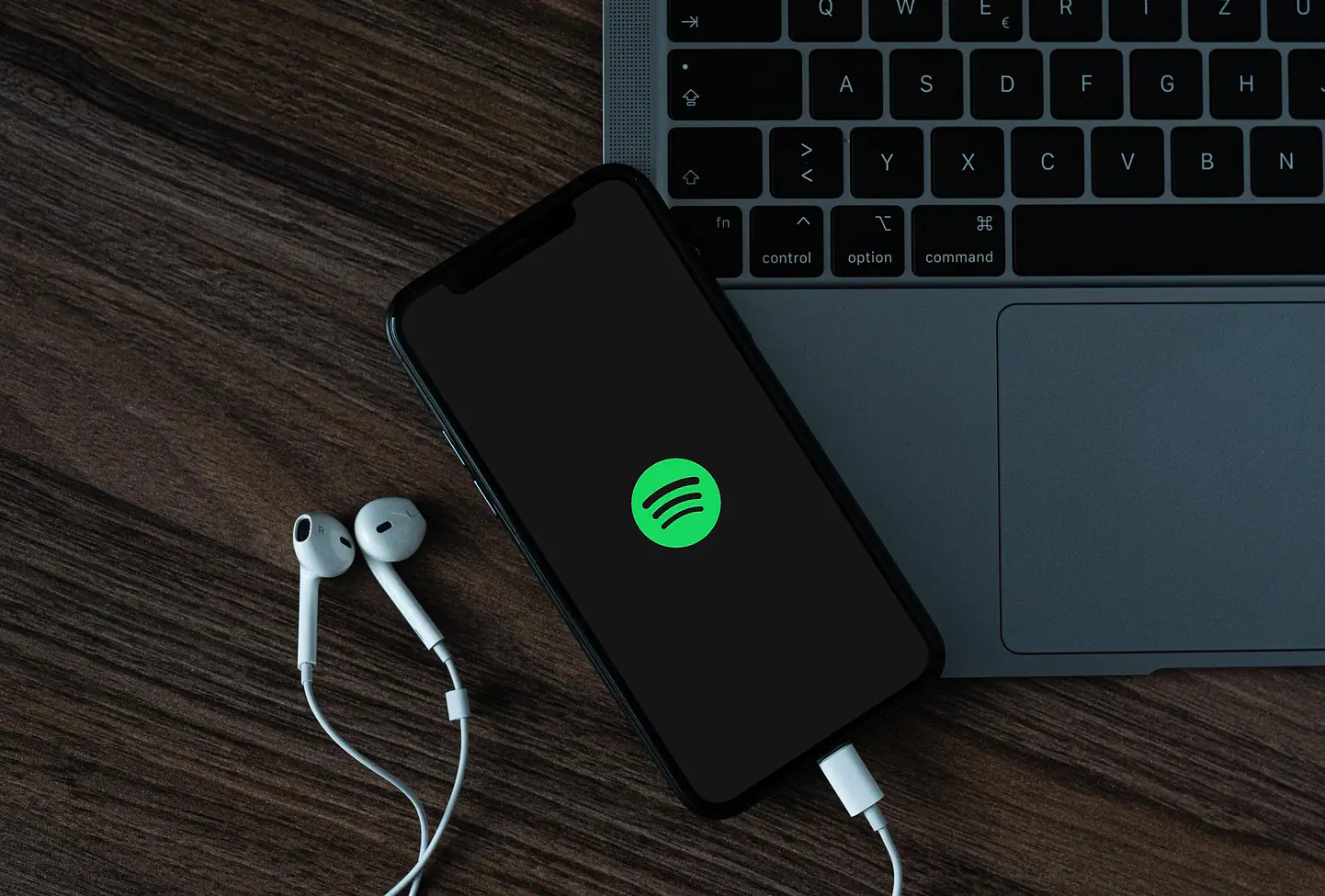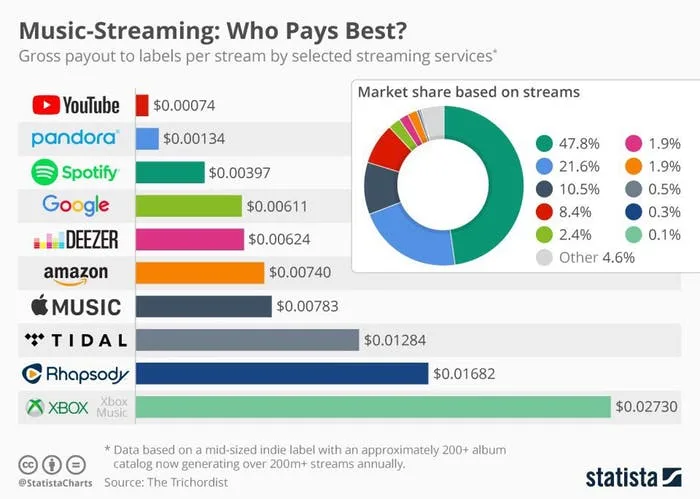
Spotify royalty changes were recently put into effect. Let’s explore their motivation, what this means for aspiring artists, and what they can do about it in 2024!
Changes to the Spotify royalty program

What was once long-circulating rumors of Spotify royalty changes are finally here. The three big changes that Spotify has announced for 2024 are:
- Click farming penalties: The pervasive issue of click farming may become much harder for fraudsters with new advanced detection. This applies to any music distributors found using so-called “click bots” to gain artificial listens.
- Noise track length increase: Spotify will require any “noise track” to be at least two minutes long to receive royalties.
- Listen minimums: The most divisive change requires each track to garner at least 1,000 listens per year for payout eligibility.
Spotify estimates that in 2024 these changes will result in $40 Million being directed from smaller independent artists to those above 1000 listens. This also means that nearly 2/3rd’s of all songs on the platform will no longer make money. Even ignoring the fraudulent streams, which make up as much as 10%, this leaves many indie artists without any payout.
The effect on indie artists
Spotify claims that the changes being made are beneficial to the industry, but what do indie artists think? Requiring a stream threshold is problematic for the many independent artists who don’t get many views on their individual works. For these artists to receive any royalties for their songs, they would need to hit the threshold for each track. Otherwise, those royalties are forfeited and ultimately go to more successful artists.
Spotify contends that their royalty changes are fair and increase compensation to artists who provide the most value with listens. They argue that the old model left indie artists with a tiny amount of earnings that often didn’t meet the distributor minimums for payout. As seen in the chart below, under the old model, Spotify was giving the 3rd to least payment amount per stream. Only time will tell how concentrating payments in the more successful streams will affect artists.

Spotify also references other streaming platforms, such as YouTube, as justification for their changes. YouTube has long used a model which only allows monetization of channels that meet all of their requirements such as at least 1000 subscribers and at least 4000 hours of watch time per 12 months. Incidentally, they also give the lowest of all platforms for music listens/views.
Some aspiring artists may be disheartened by the new requirements, but everyone can be happy that Spotify is stepping up efforts to detect fake plays. When any artist, label, or distributor can buy clicks from third-party companies, it undermines those who genuinely gather attention for their songs. In response, Spotify plans to fine any labels or distributors engaged in this practice.
What Now?
Streaming platforms like Spotify are constantly changing their revenue models, which affects how artists can earn from their fans. Now, more than ever, artists need support to reach a sustainable career. That’s why JamWith was born as a platform that lets artists easily connect, collab, and share their music. Among many other features, our artists can unify their content from Spotify, YouTube, etc., in one place to embed their portfolio for free and increase their exposure.
The music industry is more competitive than ever and success is difficult without professional backing. JamWith is looking to change that. Our mission has always been to champion and support aspiring musicians. In 2024 we will be working harder than ever to get our users 1000 listens and far beyond. We will provide you with the tools that you need as an independent artist so you can focus on your music instead of being left to figure everything out alone.
We want you to be able to customize your profile to match your musical identity whether you are a Singer/Rapper, Beatmaker, Mix/Master Engineer, or DJ/Performer. Then use our platform to discover other profiles and collaborate with them or exchange services. The JamWith algorithm will help match your profile with the most suitable accounts. Share your JamWith profile with friends, on a business card, or on any socials for a direct link to all of your content and events.
A few top features on JamWith
- Highlights: An easily adjustable reel for your links, content, and events.
- Headline: Set a headline to tell us and other users exactly what you need so we boost your signal.
- Skills and influences: Show the world your skills and genres or artists that inspire you (with Spotify integration).
- Events calendar: Help people keep up to date with you by putting in important dates for shows, album/song releases, educational classes, etc.
These features help us to connect you with the community to increase your exposure and earning opportunities. You will have access to collaborating with other artists, venues, performers, and event promoters like never before. We have so many more features coming soon so come check out what we can do for you!
Let JamWith be your music promotion superpower
Introducing JamWith, the Linkedin for the music community. Sign up now!
Join our Discord to get involved with a growing community of talented artists and get opportunities for features, collabs, and feedback! Subscribe to the JamWith Briefing newsletter for updates and to be kept up-to-date on tips, music industry trends, and the innovative tools we are developing to make collaboration and artist showcasing effortless. To discover how JamWith can enhance your music career, check our page.
Tips to navigate Spotify royalty changes in 2024
- Up your quality: No payout for tracks that don’t meet the threshold of 1,000 plays/year. So focus on high-quality music to engage listeners.
- Diversify platforms: Explore Apple Music, Amazon Music, and YouTube for additional revenue streams beyond Spotify.
- Social media and playlists: Boost streams through a strong online presence, collaborating with influencers, and submitting music to curated playlists.
- Live performances and merchandise: Generate income and connect with fans through live performances, virtual concerts, and merchandise sales. Platforms like Patreon and Bandcamp can help offer exclusive content.
- Stay informed: Understand the legal and contractual aspects of streaming platforms. Stay updated on industry changes through webinars and advice from professionals.
- Collaborate and network: Connect with artists, producers, and songwriters for exposure, joint projects, and cross-promotion.
- Track your data: Use analytics tools to monitor streaming data, identify trends, understand your audience, and optimize music promotion strategies.
👇 👇 👇 👇 👇 👇
Tune in and share your opinion below (anonymous)!
We will provide the results and consider them when writing future articles.

Which AI tool would catapult your music career?
